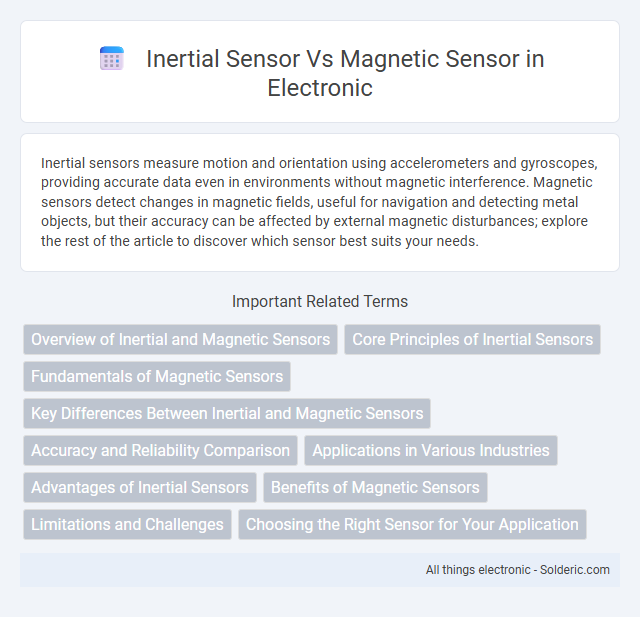Inertial sensors measure motion and orientation using accelerometers and gyroscopes, providing accurate data even in environments without magnetic interference. Magnetic sensors detect changes in magnetic fields, useful for navigation and detecting metal objects, but their accuracy can be affected by external magnetic disturbances; explore the rest of the article to discover which sensor best suits your needs.
Comparison Table
| Feature | Inertial Sensor | Magnetic Sensor |
|---|---|---|
| Definition | Device measuring acceleration, angular velocity (e.g., accelerometers, gyroscopes) | Device detecting magnetic fields and direction (e.g., magnetometers) |
| Primary Use | Motion tracking, orientation, navigation | Compass heading, metal detection, magnetic field measurement |
| Key Outputs | Acceleration data, angular rate | Magnetic field strength, heading angle |
| Advantages | Works indoors/outdoors, no external field needed, fast response | Provides absolute heading reference, low power consumption |
| Limitations | Drift over time, sensitive to vibrations | Disturbed by nearby metal/electronic interference |
| Common Applications | Smartphones, drones, automotive stability control | Digital compasses, metal detectors, smartphones |
| Sensor Types | Accelerometer, Gyroscope | Hall Effect sensors, Fluxgate magnetometers |
Overview of Inertial and Magnetic Sensors
Inertial sensors detect motion and orientation by measuring accelerations and angular velocities using accelerometers and gyroscopes, providing real-time data for navigation and stabilization. Magnetic sensors, such as magnetometers, measure magnetic fields to determine direction relative to the Earth's magnetic field, essential for compass applications and heading correction. Your choice between these sensors depends on the required accuracy, environmental conditions, and whether absolute orientation or relative motion tracking is needed.
Core Principles of Inertial Sensors
Inertial sensors operate based on the detection of acceleration, angular velocity, and gravitational forces using accelerometers and gyroscopes, which measure changes in motion without external references. These sensors rely on microelectromechanical systems (MEMS) technology to provide precise data on an object's orientation and movement by detecting inertia forces. Compared to magnetic sensors that measure magnetic fields, inertial sensors offer independent motion tracking crucial for navigation, robotics, and wearable technology, enabling your device to respond accurately to changes in position and velocity.
Fundamentals of Magnetic Sensors
Magnetic sensors operate based on the detection of changes in magnetic fields, utilizing principles such as the Hall effect, magnetoresistance, and fluxgate mechanisms to measure magnetic flux density and direction. These sensors are essential for navigation, position sensing, and current measurement by converting magnetic signals into electrical outputs. You can rely on magnetic sensors for precise orientation data where magnetic interference is minimal, contrasting with inertial sensors that track motion through accelerometers and gyroscopes.
Key Differences Between Inertial and Magnetic Sensors
Inertial sensors detect acceleration, angular velocity, and orientation by measuring forces acting on a device, relying on accelerometers and gyroscopes, whereas magnetic sensors measure the strength and direction of magnetic fields, often using magnetometers. Your choice depends on application requirements: inertial sensors excel in tracking motion and orientation without external references, while magnetic sensors provide absolute heading information based on Earth's magnetic field. Combining both sensor types enhances accuracy in navigation and positioning systems by compensating for their individual limitations.
Accuracy and Reliability Comparison
Inertial sensors, including accelerometers and gyroscopes, provide high accuracy and reliability in detecting motion and orientation by measuring linear acceleration and angular velocity with minimal external interference. Magnetic sensors, such as magnetometers, rely on Earth's magnetic field and are susceptible to distortion from nearby metallic objects and electromagnetic interference, often reducing their reliability in complex environments. Combining both sensor types in sensor fusion algorithms enhances overall accuracy and robustness in navigation and motion tracking applications.
Applications in Various Industries
Inertial sensors are extensively used in aerospace and automotive industries for precise motion detection, navigation, and stability control, leveraging accelerometers and gyroscopes to measure linear and angular movement. Magnetic sensors find critical applications in consumer electronics and industrial automation by detecting magnetic fields for position sensing, motor control, and compass functionality. Both sensor types play vital roles in healthcare devices and robotics, enabling accurate tracking and environmental interaction based on their distinct sensing principles.
Advantages of Inertial Sensors
Inertial sensors offer precise motion detection and orientation tracking without relying on external magnetic fields, ensuring consistent performance in environments with magnetic interference. They provide rapid response times and high sensitivity, making them ideal for applications requiring accurate acceleration and angular velocity measurements. Your device benefits from these sensors through enhanced stability and reliability in navigation and motion-sensitive technologies.
Benefits of Magnetic Sensors
Magnetic sensors offer precise orientation and heading information by detecting Earth's magnetic field, making them essential for accurate compass applications and navigation systems. They provide reliable measurement unaffected by accelerations or vibrations that commonly disrupt inertial sensors. These sensors enable long-term stability and low power consumption, making them well-suited for wearable devices, smartphones, and robotics.
Limitations and Challenges
Inertial sensors face limitations such as drift errors and sensitivity to vibrations, making long-term accuracy challenging without external reference points. Magnetic sensors are susceptible to interference from nearby ferrous materials and electromagnetic fields, which can distort readings and reduce reliability. Both sensor types require complex calibration and filtering techniques to mitigate environmental and operational challenges for precise measurement.
Choosing the Right Sensor for Your Application
Inertial sensors, such as accelerometers and gyroscopes, excel in measuring motion and orientation by detecting linear acceleration and angular velocity, making them ideal for applications requiring precise movement tracking and stability control. Magnetic sensors, including magnetometers, provide accurate heading and field strength information by detecting Earth's magnetic field, which is essential for navigation and compass-based systems. You should choose an inertial sensor for high-dynamics environments and motion analysis, while magnetic sensors are better suited for orientation referencing and magnetic field detection.
inertial sensor vs magnetic sensor Infographic

 solderic.com
solderic.com